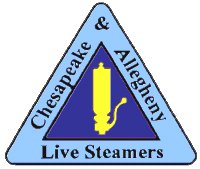Frequently Asked Questions
Lou Kohler on Bruce Hamilton’s Greenbriar
1) What is the difference between Gauge and Scale?
Gauge is the distance between the rails. Here at Leakin Park, we have a 7 1/2″, 4 3/4″, and 3 1/2″ track. This corresponds to a 1 1/2″, 1″, and 3/4″ Scale. Scale is the number of inches to the foot. 12″ scale is what you are used to in the real world. 1 1/2″ means 1 1/2″ on our large locomotives is equal to 1′ on the real thing. 1 1/2″, is 1/8 full size, 1″ is 1/12 full size and 3/4″ is 1/16 full size.
2) OK, but why are some engines listed as 1 1/2″ while others are 1.6″?
When live steam started several gauges were used, in the Northeast and the rest of the world the gauge is 7 1/4″, here, south and almost everything west it is 7 1/2″. Neither of these is scaled correctly from real life. However, if you use a 7 1/2″ gauge and 1.6″ Scale you are right on. This works out to be 1/7.5 instead of 1/8 full size. As a side bonus, it is also correct for narrow gauge modeling in the 2 1/2″ scale.
3) What’s the difference between Hard and Soft coal and why do some engines use one but not the other?
Hard coal or Anthracite is 82% Carbon and 4% Volatile. Soft coal or Semi-Bituminous is 71% Carbon and 18% Volatile. Bituminous coal is 58% Carbon and 33% Volatile. Volatile means a lot of the stuff in the coal goes out the stack unburned because the coal releases it before it gets a chance to burn. The higher the carbon content the less volatile matter there is, and the harder the coal. Hard coal burns very clean, you will seldom see smoke from President Washington for example. However it is harder to get it to burn and keep it burning so on some engines, usually due to firebox design, soft coal is used. It is easier to get burning and keep burning, plus some people think steam locos should smoke.
4) How fast will it go?
We get this one a lot! In real life there were several 100mph Passenger trains in use in the 30’s, 40’s and 50’s. The highest Steam Speed was over 124mph. On our track we limit the speed to a breathtaking 6MPH, (this translates to about 48mph in scale). The models due to lighter main and side rods and lighter pistons then their full size counter parts are capable of real speeds of 15-30mph which becomes a completely unrealistic 120-240mph in scale! (Plus it will age you real fast).
5) How do I get one?
There are several ways, first build it from scratch. Some people find the original blueprints and scale them down, cast and machine their own parts. Very satisfying for those with the time (in years) and the machining ability to do so. Second is to buy from a manufacture who can supply either rough castings of parts or machined parts, (usually still needing to be drilled and tapped for screws). This speeds up construction by several years but in most cases increases cost, but allows those with more modest machine shops to still build one. Third, buy one already built. This is reasonably quick depending on the manufacture but is expensive. The fourth way is to find one used. Several magazines have adds for used engines, many built by fine craftsmen with great detail. Recognize that due to the nature of the engines (burning fuel, water of unknown quality, wear and tear) some work may be needed ranging from minor, (bushings, leaking pipe fitting, O-rings or piston rings, etc.) to major such as needing a new boiler. Still it is quite possible to keep these engine running much longer than we will, (Ed Diehl’s pacific was built in 1950 and is on it’s fourth owner).
